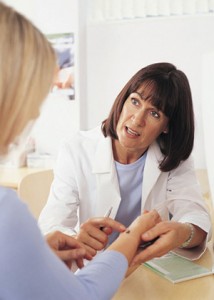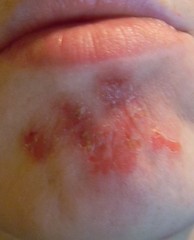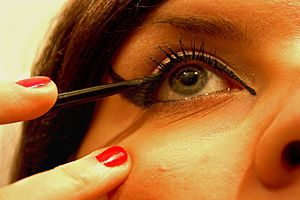
Older man with acne
(Photo credit: Getty Images)
Acne is not necessarily a disease of the young. Sometimes it lasts into the forties, which can be quite disturbing to the patient and his or her family. Lumps on the face of a person in the forties require a different approach to diagnosis and to treatment.
These lumps are either acne or a condition called rosacea. More about rosacea later. We’re seeing more and more cases of acne (even the more severe nodulocystic kind that some older patients appear to have) in people well beyond their teenage years.
Although we think a lot of this has to do with the use of cosmetics by women, we suspect that acne persists in men because of the constant presence of large amounts of male hormone in a person who has a genetic heritage for a predisposition to acne.
Whiteheads in the Elderly
Whiteheads and blackheads on the faces of the elderly are often a problem known as Favre-Racachout syndrome, also known as nodular elastoidosis with cysts and comedones. Sounds complicated, but it really does describe it well.
The problem results from the loose skin (elatoidosis) that accompanies TMB (too many birthdays) and damage from years of sunlight exposure. Small blackheads (comedones) form all over the upper cheeks and eye areas (the orbits), which need a type of acne surgery (expression of blackheads by the dermatologist).
A face-lift usually helps the Favre-Racachout problem too. At least 60 percent of patients with this problem have the loose eyelid skin that is just ripe for what the plastic surgeons call a blepharoplastry, or lid job. This is one of the neatest operations ever invented, and it can make you look years younger. Think about it!
Treatment of this blackhead condition centers on pushing out the whiteheads and trying to prevent them in the future. We use a little hairpin. It’s called a comedo (blackhead) extractor. The trick is knowing how to do the procedure so you don’t injure yourself.
It’s for this reason that I wouldn’t ask you to go down to the drugstore and buy yourself one of these gadgets. Have an expert, your dermatologist do it.
By the way, this problem of whiteheads and blackheads around the eyes is one of the all-time most popular “Say, Doc” diseases. That’s a condition discovered on a relative of an office patient as the patient leaves the room.
Usually the patient leaves first and the relative hangs behind for a mini-office visit, and says, “Say, Doc, what do you suppose these white things are on my cheeks?”
Acne Induced by Physical Pressure
As we have said, acne can be a process that does not resolve until middle age in some men. While there are not very many sixty-five-year-old with acne, it’s impossible to tell the individual patient when his or her own case of acne will subside.
We believe that treatment of acne may keep the patient asymptomatic; that is, the patient may have a tendency for the condition to occur, but this tendency is effectively masked while the disease essentially burns itself out.
Treatment, in other words, is a protective screen in front of the acne forest fire, and we keep the screen up as long as necessary to prevent damage. Almost everyone does indeed stop forming new bumps as they age.
Sometimes there are causes you would not normally suspect for acne in certain regions of the body, for instance, the back. A salesman who drove about 500 to 800 miles a week had back acne. He did not have any lesions or whatsoever on his face. It was discovered that his seat had vinyl seat covers.
Sitting on this occlusive surface for some time made his back hot and sweaty. He went to a dermatologist to seek a treatment regimen and was advised to get a soft sheepskin cover for his seat. This resulted in a prompt resolution of his back acne.
The salesman had developed what is known as tropical acne – acne that results from intense heat and occlusion of the skin, combined with the bad influence of widespread pressure upon skin that bears oil glands. This results in tremendous and explosive acne in some persons!
There was a case of pressure-induced acne in a young woman named Sherry who had very severe acne on the right cheek only. The bumps were so close together that her whole cheek was covered with papular, or small-bump, acne.
So how did this happen to her? She slept on her right hand every single night. So it was clear that Sherry’s hand was causing her acne. She was prescribed a soft, brown garden glove for her to wear only at night and was told to keep her pillow between her hand and her face.
Sherry’s acne cleared almost magically. From this case, you can see the effect of pressure on the skin is indeed causing acne to breakout.
Helmet and chin-strap acne are two variants that really annoy some sports-loving teens. Sometimes it is extraordinarily difficult to get these areas cleared without stopping the pressure by the strap. Drying agents used on the forehead and chin during football season can help calm the eruption, but for the most part, it’s necessary to alleviate the pressure.
This can be done by padding the chin-strap area and helmet contact points with a very soft felt material. Its’ not perfect, but it may help.
Dermatopathic Lymphadenopathy
Occasionally victims of severe acne notice swellings in the neck areas below and underlying their complexion problems. This condition is called dermatopathic lymphadenopathy. This means that the tiny lymph glands under the chin area are draining the products of inflammation from your acne areas.
These products lodge temporarily within the glands, irritate them, and cause them to swell. The lumps can get quite tender and sometimes persist until the acne itself has come under control. The presence of inflammation in the lymph glands of the neck will often lead your dermatologist to consider that there may be strep or staph infection down inside the facial acne bumps.
For this reason, your doctor may choose to change your antibiotic to one that will knock out these bacteria. This change would be temporary, just until the supervening infection is wiped out, and then you would most probably be put back on your routine anti-acne antibiotics.
Cosmetics and Acne
As I’ve said before, acne is a disease of an ever older age group these days, a fact that has distressed many of us in dermatology.
We believe there are two general reasons for this. First, we have tried over the years to increase patient awareness of what can be done for acne so that many men and women now consult dermatologists earlier for a few bumps rather than put up with them until they scar and go away on their own which is not always the case. It’s this patient concern that has brought about the demand for ever more effective acne medications.
Second, cosmetic industry leaders, while doing what they can to protect against cosmetic-induced acne, have not completely succeeded. That is, many cosmetics are still inducing acne. This situation is compounded for older women since our looks-conscious society demands a continued youthful appearance.
The result often is an increasing use of cosmetics to mask minor flaws. Then the cosmetics themselves can cause a plugging of oil glands, or some change in the secretion of oil, which we see later as “cosmetica” (acne induced and sustained by cosmetics).
Acne cosmetic is a very severe and widespread problem. It was discovered when researches were testing the inner ears of rabbits for the irritant potential of cosmetics. Some of their results were not irritation, but whiteheads and blackheads on the rabbit ear skin.
So substances such as cold creams and makeup are now used as the test substances to produce experimental acne in which new therapeutic medications may be tried.
Now I’m not trying to kill off the cosmetic industry. I think cosmetics are a prime requisite in our society today, and I would not ask women to go without them, since there are now systems that can be used which do not induce new acne.

Dermatologist
Some of the best systems of cosmetics that do not generally cause acne are Allercreme, Lancome, Clinique brands. However, even within these brand groupings I would advise avoidance of the companies’ “acne treatment programs,” because they are generally not effective and can result in delay of treatment of your acne when what you may need most is to see the dermatologist as soon as possible.
Until these newer, noncomedogenic cosmetic systems came along; my standard axiom was “
A little makeup, a little paint, sure makes acne where it ain’t!” So if you have any tendency toward acne, and if you want to give yourself a fighting chance, you should use one of the brands recommended here or ask your dermatologist for one that is preferred by him or her.
Research shows that to do otherwise may be gambling with the only face you’ve got.








